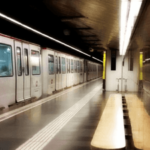
Our Tour Guide Tona Takes Us Behind The Scenes
TODAY WE GET TO KNOW TONA'S SECRETS
Tona (a nickname for Marta > Martona > Tona) started guiding groups around Scandinavia. She had answered an add on the press for tour guides in Switzerland, but shortly after receiving her training her destination changed and she was sent to Norway instead. After working there for some time she indeed ended up guiding in Switzerland for Spanish travelers thanks to some contacts she had from her hometown, Lleida.
Here is our interview with Tona:
1
What’s your favorite area in Barcelona?
I love the Call – the medieval Jewish Quarter. Many guests tell me that I look like I could be Jewish. I’m not, but… who knows? My grandfather’s last name was Salomó (Solomon in Catalan), so maybe I have some old forgotten heritage! There isn’t much left from its Jewish past, and it’s not even 100% sure that what we call the “Main Synagogue” of the middle ages was really a synagogue…
But when we walk around St. Domènech del Call street and the other alleys of the Jewish Section, I love to explain the history behind its stones and I feel almost like a tour guide – actress making people feel what happened even if there aren’t that many elements left.
2
What's your favorite museum?
I love the Miró Foundation because not that many people are familiar with Joan Miró (some even think he was a woman because “Joan” is a girl name in English – but in Catalan is a male name). And being off the beaten path, the museum is quite empty – what makes you feel very special when you have such a place just to yourself.
So it’s lots of fun making people discover his art, the personal language he created to escape from a very hard reality during war time, the zen and spirituality he discovered in Japan. His paintings are full of visual beauty so “understanding” what’s behind isn’t really necessary, but it adds up to the experience and it makes you travel to a world of poetry.
Besides, he had a very human side: Dali and Picasso were divas, but Miró could have been your grandpa (a very creative grandpa that continued to challenge the art world even in his last years.
3
What about your favorite food?
I’m a fan of ensaladilla rusa. It’s a very classic tapa made of boiled small potato cubes, carrot, green beans, green peas, canned tuna and mayo, a very traditional recipe that often moms will cook for family gatherings because it’s easy to make despite having to cut all the veggies is a laborious job.
This Summer I stayed in the city working, so I had to made up some plans for my “stay-cation” and with my partner we decided to go on a mission to find the best ensaladilla rusa in town. We tried it in many bars, and our favorite was the one at Santa Agustina, because they add a touch of truffle to it. Yum!
4
What’s the most unusual thing you’ve done on a tour?
Once I took a family truffle foraging. They were a group of 8 or 10 people that owned a truffle farm. We went to the Moianès county (an area that I hadn’t been to before and I had to prepare for the tour my speech about the village of Sant Quirze Safaja and the poet Marius Torres who spent the last years of his life there).
With them we visited a plantation where we were received by a mycologist and the owner of the real state with his truffle hunting dog. We found one, that we eat during lunch grated on top of our food.
5
What’s your favorite Catalan tradition?
Village “Festes Majors”, a village or town main festival. When I was a child I used to spend the summer in a place called La Llacuna and the week of the Festa Major was special: there was music, activities for the kids, dancing, the entire village organized a dinner picnic by a fountain… To me, Summertime means Festa Major. In large towns like Lleida where I grew up, it wasn’t as intense but in exchange we had the Aplec del Cargol – the Snails Festival.
My father used to cook snails for one of the festival teams (“colla” in Catalan) – we were between 70 to 100 people just in that team! But even if eating snails is the theme of the festival, the food was the least important to me: the best was meeting people that I maybe only would see that only day of the year. At 8AM started the parade that led you to the riverside where the teams cooked.
Do you have any more questions for Tona?
Marta
MORE BARCELONA TIPS FOR YOU:
SHARE WITH YOUR TRAVEL MATES
RESEARCHING FOR A TRIP IS TIME-CONSUMING…
Need more inspiration?
Our 100% FREE Barcelona Collection will give you everything you need to organize the trip of your lifetime to Barcelona.
BEST INSIDER TIPS FROM THE PROS!













